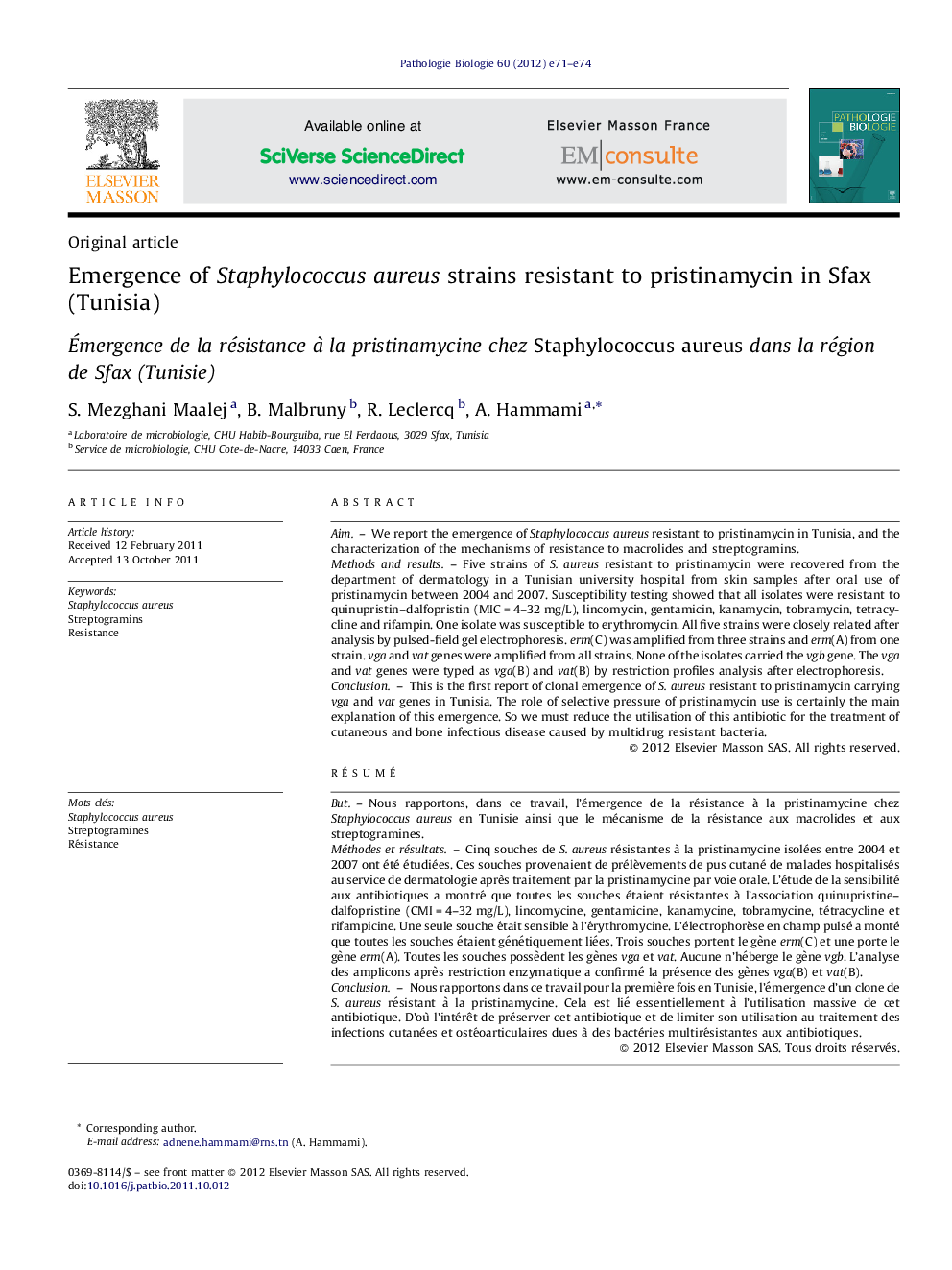| کد مقاله | کد نشریه | سال انتشار | مقاله انگلیسی | نسخه تمام متن |
|---|---|---|---|---|
| 4136080 | 1606679 | 2012 | 4 صفحه PDF | دانلود رایگان |

AimWe report the emergence of Staphylococcus aureus resistant to pristinamycin in Tunisia, and the characterization of the mechanisms of resistance to macrolides and streptogramins.Methods and resultsFive strains of S. aureus resistant to pristinamycin were recovered from the department of dermatology in a Tunisian university hospital from skin samples after oral use of pristinamycin between 2004 and 2007. Susceptibility testing showed that all isolates were resistant to quinupristin–dalfopristin (MIC = 4–32 mg/L), lincomycin, gentamicin, kanamycin, tobramycin, tetracycline and rifampin. One isolate was susceptible to erythromycin. All five strains were closely related after analysis by pulsed-field gel electrophoresis. erm(C) was amplified from three strains and erm(A) from one strain. vga and vat genes were amplified from all strains. None of the isolates carried the vgb gene. The vga and vat genes were typed as vga(B) and vat(B) by restriction profiles analysis after electrophoresis.ConclusionThis is the first report of clonal emergence of S. aureus resistant to pristinamycin carrying vga and vat genes in Tunisia. The role of selective pressure of pristinamycin use is certainly the main explanation of this emergence. So we must reduce the utilisation of this antibiotic for the treatment of cutaneous and bone infectious disease caused by multidrug resistant bacteria.
RésuméButNous rapportons, dans ce travail, l’émergence de la résistance à la pristinamycine chez Staphylococcus aureus en Tunisie ainsi que le mécanisme de la résistance aux macrolides et aux streptogramines.Méthodes et résultatsCinq souches de S. aureus résistantes à la pristinamycine isolées entre 2004 et 2007 ont été étudiées. Ces souches provenaient de prélèvements de pus cutané de malades hospitalisés au service de dermatologie après traitement par la pristinamycine par voie orale. L’étude de la sensibilité aux antibiotiques a montré que toutes les souches étaient résistantes à l’association quinupristine–dalfopristine (CMI = 4–32 mg/L), lincomycine, gentamicine, kanamycine, tobramycine, tétracycline et rifampicine. Une seule souche était sensible à l’érythromycine. L’électrophorèse en champ pulsé a monté que toutes les souches étaient génétiquement liées. Trois souches portent le gène erm(C) et une porte le gène erm(A). Toutes les souches possèdent les gènes vga et vat. Aucune n’héberge le gène vgb. L’analyse des amplicons après restriction enzymatique a confirmé la présence des gènes vga(B) et vat(B).ConclusionNous rapportons dans ce travail pour la première fois en Tunisie, l’émergence d’un clone de S. aureus résistant à la pristinamycine. Cela est lié essentiellement à l’utilisation massive de cet antibiotique. D’où l’intérêt de préserver cet antibiotique et de limiter son utilisation au traitement des infections cutanées et ostéoarticulaires dues à des bactéries multirésistantes aux antibiotiques.
Journal: Pathologie Biologie - Volume 60, Issue 6, December 2012, Pages e71–e74